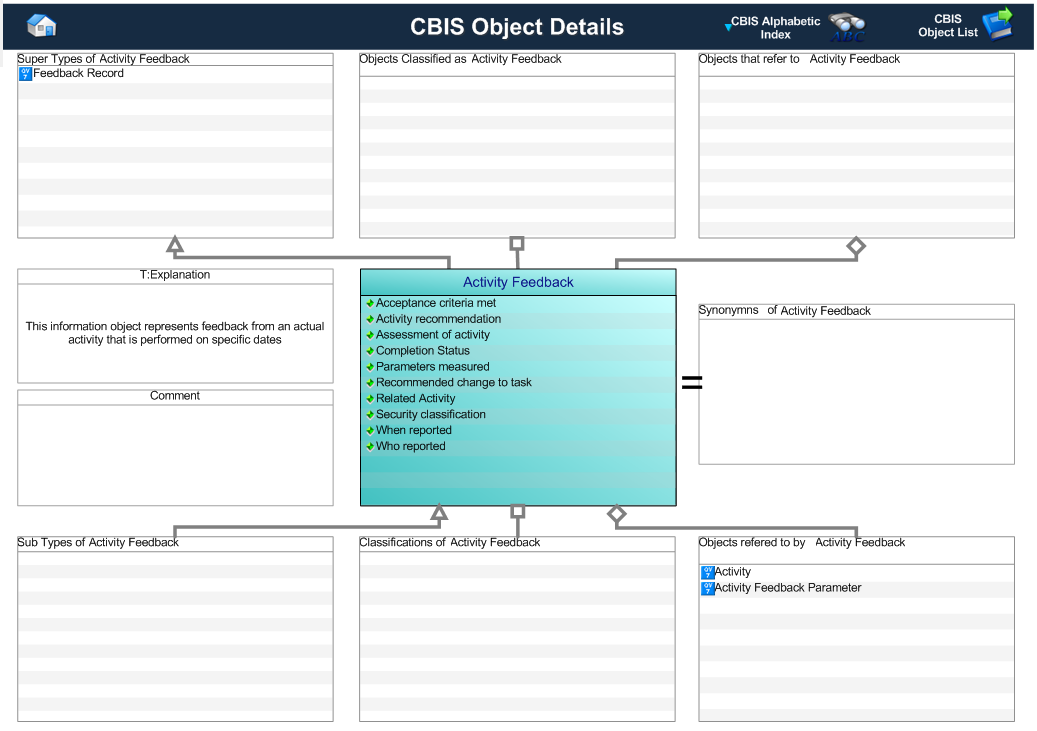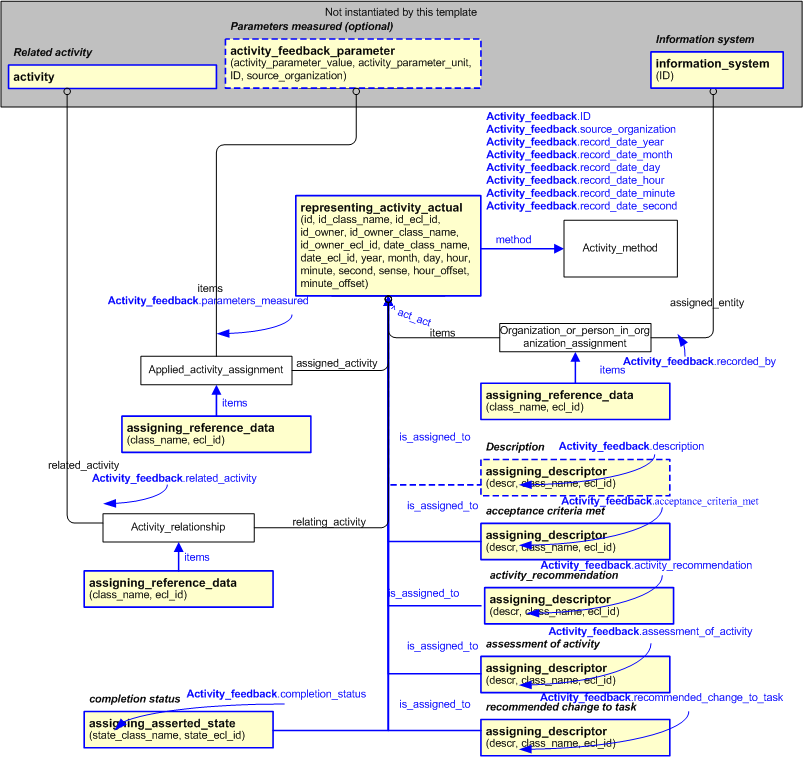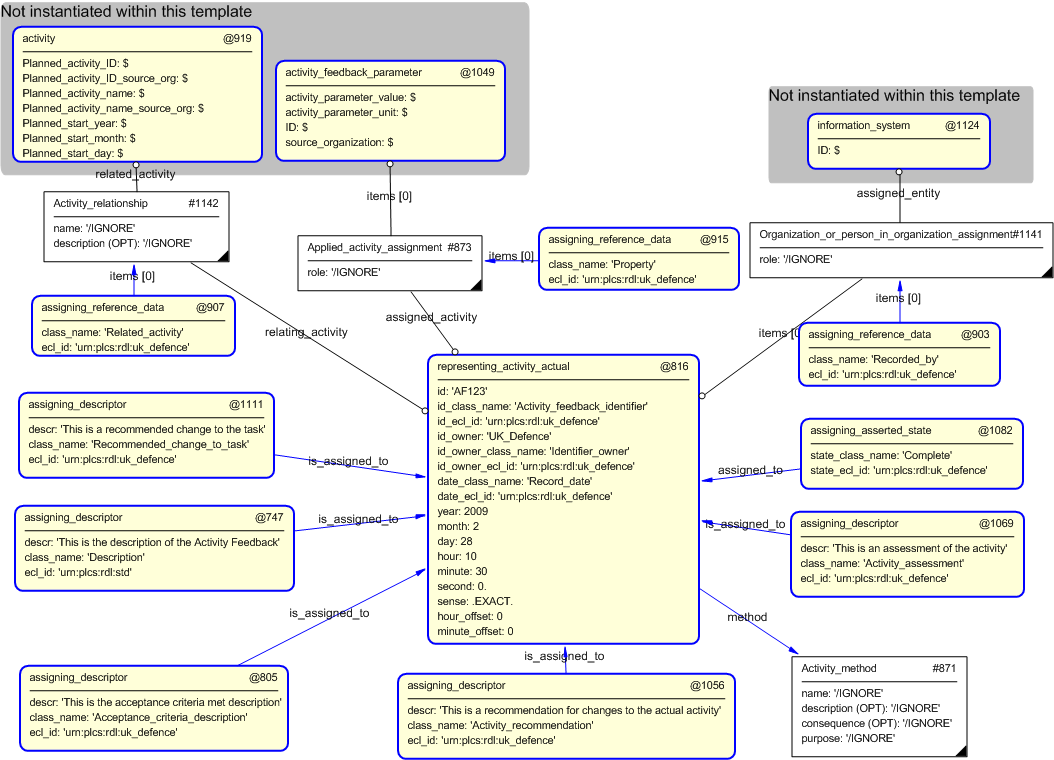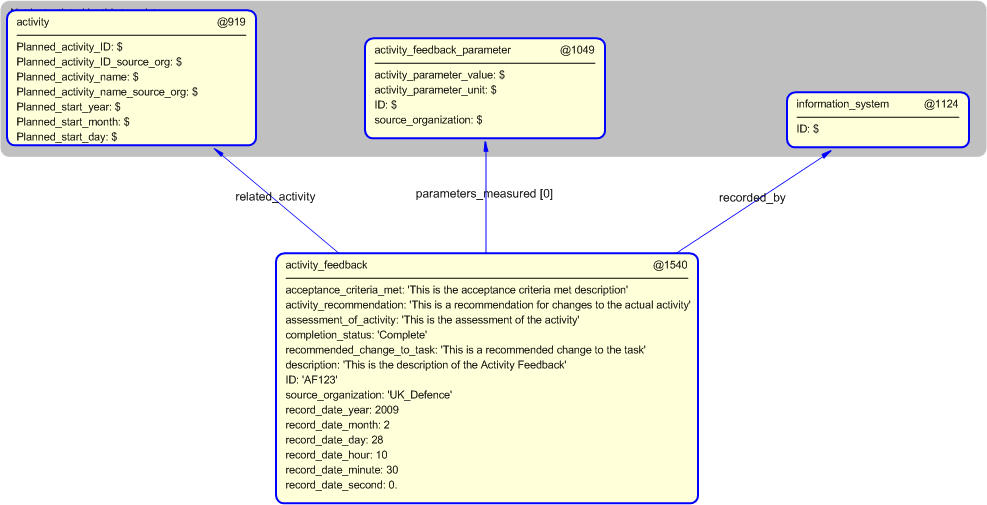Template:— activity_feedback (act_fdbk)
Context:— UK_Defence |
Date: 2009/12/11 19:29:54
Revision: 1.5
|
This section specifies the template activity_feedback.
NOTE
The template has been defined in the context of
UK_Defence.
Refer to the business context for details of related templates.
NOTE
An explanation of a template and the associated instantiation path is
provided in the
Template overview
section.
This template describes how to represent feedback from an actual activity that is performed on specific dates
The activity feedback business object is used by those UK_Defence Data Exchange
Specifications that require information about the feedback from an actual activity that is performed
on specific dates.
Figure 1 — Graphical Representation for Business Object Activity Feedback
Activity Feedback:
The definition of an Activity Feedback object is:
Data about the identification of the feedback from an actual activity that is performed
on specific dates.
|
Attribute name
|
Attribute description
|
Attribute type
|
Optionality
|
| Acceptance criteria met |
This is a description of the acceptance criteria met. |
Intrinsic |
Mandatory |
| Activity recommendation |
This is a recommendation for changes to the actual activity. |
Intrinsic |
Mandatory |
| Assessment of activity |
This an overall assessment of the activity. |
Intrinsic |
Mandatory |
| Completion Status |
This attribute represents the completion status of the activity. |
Intrinsic |
Mandatory |
| Parameters measured |
This a reference to the measured activity parameters. |
Relationship to Activity Feedback Parameter |
Optional (0:?) |
| Recommended change to task |
This is a recommended change the task definition as a result of observing the actual activity. |
Intrinsic |
Mandatory |
| Related Activity |
This is the reference to the activity for which the activity feedback record is created. |
Relationship to Activity |
Mandatory |
Table 1 — Activity Feedback attribute details
The EXPRESS-G diagram in
Figure
2
shows the templates and EXPRESS entities that are required
to represent the template
"activity_feedback".
The text highlighted in blue shows the template parameters.
Figure 2 — An EXPRESS-G representation of the Information model for activity_feedback
The graphic for the template to be used in other EXPRESS-G diagrams
is shown in Figure
3
below.
Figure 3 — The graphical representation of the activity_feedback template
The following input parameters are defined for this template:
This is a description of the acceptance criteria met.
This is a recommendation for changes to the actual activity.
This an overall assessment of the activity.
This attribute represents the completion status of the activity.
This a reference to the measured activity parameters.
This is a recommended change the task definition as a result of observing the actual activity.
This is the reference to the activity for which the activity feedback record is created.
This is the description of the Activity Feedback.
This is the identifier of the Activity Feedback.
The organization that created the identifier. Additionally
a Person or Information System could be defined when either of these are the source; see Identifier template.
The year component of the date and time on which the activity feedback record was made.
The month component of the date and time on which the activity feedback record was made.
The day component of the date and time on which the activity feedback record was made.
The hour component of the date and time on which the activity feedback record was made.
The minute component of the date and time on which the activity feedback record was made.
This parameter is optional. If not given, it will remain unset.
The second component of the date and time on which the activity feedback record was made.
This parameter is optional. If not given, it will remain unset.
This is the reference to the person or system which recorded the feedback
The following reference parameters are defined for this template:
Allow the
Activity_actual
entity instantiated in this path to be referenced when this template is used.
%^target = $activity_feedback.act_fbk%
The following parameter combinations specify a uniqueness constraint:
Unique constraint: Activity_feedback
Each instance of the
entity
(
Activity_actual)
within the data set shall be uniquely identified
by a combination of the following parameters on this
template (activity_feedback) namely:
related_activity,
ID,
recorded_by.
The
instance is
referenced by the following template parameter:
act_fbk.
The instantiation path shown below specifies the entities that are to be
instantiated by the template.
A description of templates and the syntax for the instantiation path is
provided in the
Templates Help/Information section.
Activity_methodActivity_method.name = '/IGNORE'
Activity_method.description = '/IGNORE'
Activity_method.consequence = '/IGNORE'
Activity_method.purpose = '/IGNORE'
%^act_method =
Activity_method%
/
representing_activity_actual(
id=@ID,
id_class_name='Activity_feedback_identifier',
id_ecl_id='urn:plcs:rdl:uk_defence',
id_owner=@source_organization,
id_owner_class_name='Identifier_owner',
id_owner_ecl_id='urn:plcs:rdl:uk_defence, date_class_name=')/
%^act_fbk = $representing_activity_actual.act_act%
-- [Optional Description] /
assigning_descriptor(
descr=@description,
class_name='Description',
ecl_id='urn:plcs:rdl:uk_defence',
is_assigned_to=^act_fbk)/
-- Acceptance criteria /
assigning_descriptor(
descr=@acceptance_criteria_met,
class_name='Acceptance_criteria_description',
ecl_id='urn:plcs:rdl:uk_defence',
is_assigned_to=^act_fbk)/
-- Activity recommendation /
assigning_descriptor(
descr=@activity_recommendation,
class_name='Activity_recommendation',
ecl_id='urn:plcs:rdl:uk_defence',
is_assigned_to=^act_fbk)/
-- Assessment_of_activity /
assigning_descriptor(
descr=@assessment_of_activity,
class_name='Activity_assessment',
ecl_id='urn:plcs:rdl:uk_defence',
is_assigned_to=^act_fbk)/
-- completion_status /
assigning_asserted_state(
state_class_name=@completion_status,
state_ecl_id='urn:plcs:rdl:uk_defence',
assigned_to=^act_fbk)/
-- relationship to parameters measured Applied_activity_assignmentApplied_activity_assignment.role = '/IGNORE'
Applied_activity_assignment.items ->
@parameters_measuredApplied_activity_assignment.assigned_activity ->
^act_fbk
%^param_measured =
Applied_activity_assignment%
/
assigning_reference_data(
items=^param_measured,
class_name='Property',
ecl_id='urn:plcs:rdl:uk_defence')/
-- relationship to related activity Activity_relationshipActivity_relationship.name = '/IGNORE'
Activity_relationship.description = '/IGNORE'
Activity_relationship.related_activity ->
@related_activityActivity_relationship.relating_activity ->
^act_fbk
%^rel_act =
Activity_relationship%
/
assigning_reference_data(
items=^rel_act,
class_name='Related_activity',
ecl_id='urn:plcs:rdl:uk_defence')/
-- relationship to recorded_by Organization_or_person_in_organization_assignmentOrganization_or_person_in_organization_assignment.role = '/IGNORE'
Organization_or_person_in_organization_assignment.assigned_entity ->
@recorded_byOrganization_or_person_in_organization_assignment.items ->
^act_fbk
%^record_by =
Organization_or_person_in_organization_assignment%
/
assigning_reference_data(
items=^record_by,
class_name='Recorded_by',
ecl_id='urn:plcs:rdl:uk_defence')/
-- recommended_change_to_task /
assigning_descriptor(
descr=@recommended_change_to_task,
class_name='Recommended_change_to_task',
ecl_id='urn:plcs:rdl:uk_defence',
is_assigned_to=^act_fbk)/
The following entities are instantiated with attributes as specified:
The instance diagram in Figure
4
shows an example of the EXPRESS entities and templates that are instantiated by the template:
/activity_feedback(acceptance_criteria_met='This is the acceptance criteria met description', activity_recommendation='This is a recommendation for changes to the actual activity', assessment_of_activity='This is the assessment of the activity', completion_status='Complete', parameters_measured='@1049', recommended_change_to_task='This is a recommended change to the task', related_activity='@919', description='This is the description of the Activity Feedback', ID='AF123', source_organization='UK_Defence', record_date_year='2009', record_date_month='2', record_date_day='28', record_date_hour='10', record_date_minute='30', record_date_second='0', recorded_by='@1124')/
(an illustration of the consolidated activity_feedback template is shown in
Figure
5 below.)
Figure 4 — Entities instantiated by activity_feedback template
The instance diagram in
Figure
5
shows the graphic symbol for the template that is to be
used in other instance diagrams. The example template is:
/activity_feedback(acceptance_criteria_met='This is the acceptance criteria met description', activity_recommendation='This is a recommendation for changes to the actual activity', assessment_of_activity='This is the assessment of the activity', completion_status='Complete', parameters_measured='@1049', recommended_change_to_task='This is a recommended change to the task', related_activity='@919', description='This is the description of the Activity Feedback', ID='AF123', source_organization='UK_Defence', record_date_year='2009', record_date_month='2', record_date_day='28', record_date_hour='10', record_date_minute='30', record_date_second='0', recorded_by='@1124')/
Figure 5 — Instantiation of activity_feedback template
Characterizations
No common characterizations of the template
activity_feedback
have been identified. However, the ISO 10303-239 EXPRESS model
may enable other assignments to the entities instantiated by the template.




